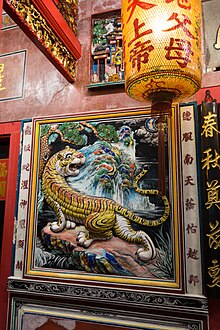Bornean tiger
| Bornean tiger | |
|---|---|

| |
| Painting of a tiger at a Buddhist temple in Kuching, Sarawak, Malaysia | |
| Scientific classification | |
| Domain: | Eukaryota |
| Kingdom: | Animalia |
| Phylum: | Chordata |
| Class: | Mammalia |
| Order: | Carnivora |
| Suborder: | Feliformia |
| Family: | Felidae |
| Subfamily: | Pantherinae |
| Genus: | Panthera |
| Species: | P. tigris |
| Population: | Bornean tiger |
The Bornean tiger or Borneo tiger is possibly an
A live Bornean tiger has not been conclusively recorded, but the indigenous Dayak people believe in its existence, and occasionally report sightings.[3][4]Characteristics
In
The Bornean tiger is considered to have been rather small in size.[7] According to the native people, it is bigger than a Bornean clouded leopard, and largely brown in colour with faint stripes.[3]
Behaviour and ecology
The Borneo tiger is thought to have preyed on ungulate species such as the Bornean bearded pig, the Bornean yellow muntjac and the sambar deer. According to the local Dayak, the tiger did not climb trees.[3]
Archaeological records

Borneo might have been connected to Palawan during the penultimate and previous glacial periods, judging from the molecular phylogeny of murids in the area.[8] Tiger parts were commonly used as amulets in South and Southeast Asia, so it is possible that the tiger parts found in Palawan were imported from elsewhere.[8][9]
It is also possible that the tiger crossed the
Alleged records
In 1975,
In culture
Natives of Borneo keep the memory of the tiger alive in their culture by treating its body parts as
See also
- Tiger populations
- Mainland Asian populations
- Sunda island populations
- Prehistoric tigers: Panthera tigris soloensis
- Panthera tigris trinilensis
- Panthera tigris acutidens
References
- ^ a b Medway, L. (1977). "The Niah Excavations and an Assessment of the Impact of Early Man on Mammals in Borneo" (PDF). Asian Perspectives. 20 (1): 51–69.
- ^ Medway, L. (1977). Mammals of Borneo: field keys and an annotated checklist. Vol. 7. Kuala Lumpur: Malaysian Branch of the Royal Asiatic Society.
- ^ a b c d e Meijaard, E. (1999). "The Bornean Tiger; Speculation on its existence". Cat News (30): 12–15.
- ISBN 978-0-8155-1570-8.
- ^ a b Piper, P. J.; R. J. Rabett, Earl of Cranbrook (2007). "Confirmation of the presence of the tiger Panthera tigris (L.) in Late Pleistocene and Holocene Borneo". Malayan Nature Journal. 59 (3): 259–267. Retrieved 2018-05-29.
- ^ .
- ISBN 0521648351.
- ^ ISBN 9781444391282.
- ISBN 978-9-4024-1106-5.
- S2CID 4421184.
- .
- S2CID 4347450.
- ^ a b Gersi, D. (1975). Dans la jungle de Bornéo (in French). Paris: Éditions G. P.
- ^ a b Sellato, B. (2019). The Other Tiger: History, Beliefs, and Rituals in Borneo. Temasek Working Paper No. 1. Singapore: Institute of Southeast Asian Studies / Yusof Ishak Institute, Temasek History Research Center.


